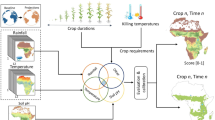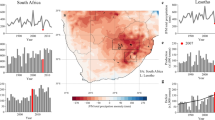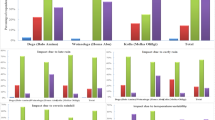Abstract
Southern Africa faces high food insecurity and projected declines in agroclimatic conditions. Multiple satellite measures indicate that cropland productivity has stagnated for most of the region except South Africa in the past 20 years, in contrast to what official crop statistics suggest. Climate trends do not explain this stagnation, with the region experiencing more rainfall and less warming than most climate model projections. A change of course is needed before climate impacts accelerate.
This is a preview of subscription content, access via your institution
Access options
Access Nature and 54 other Nature Portfolio journals
Get Nature+, our best-value online-access subscription
$32.99 / 30 days
cancel any time
Subscribe to this journal
Receive 12 digital issues and online access to articles
$119.00 per year
only $9.92 per issue
Buy this article
- Purchase on SpringerLink
- Instant access to full article PDF
Prices may be subject to local taxes which are calculated during checkout


Similar content being viewed by others
Data availability
Data used to generate all figures as well as scripts used to process and analyse satellite data are available via Zenodo at https://zenodo.org/records/15492669 (ref. 32).
Code availability
All replication code for this study is available via Zenodo at https://zenodo.org/records/15492669 (ref. 32) and via GitHub at https://github.com/LobellLab/southern-africa-trends.
References
Hertel, T. W., Baldos, U. L. C. & Van Der Mensbrugghe, D. Predicting long-term food demand, cropland use, and prices. Annu. Rev. Resour. Econ. 8, 417–441 (2016).
Fuglie, K. R&D capital, R&D spillovers, and productivity growth in world agriculture. Appl. Econ. Perspect. Policy 40, 421–444 (2018).
Berrang-Ford, L. et al. A systematic global stocktake of evidence on human adaptation to climate change. Nat. Clim. Chang. 11, 989–1000 (2021).
World Population Prospects 2022 (United Nations Population Division, 2022).
UNICEF/WHO/World Bank Group Joint Child Malnutrition Estimates (UNICEF, 2023).
IPCC Climate Change 2021: The Physical Science Basis (eds P. Arias et al.) 35–144 (Cambridge University Press, 2023).
Lobell, D. B. et al. Prioritizing climate change adaptation needs for food security in 2030. Science 319, 607–610 (2008).
Verschuur, J., Li, S., Wolski, P. & Otto, F. E. L. Climate change as a driver of food insecurity in the 2007 Lesotho–South Africa drought. Sci. Rep. 11, 3852 (2021).
Wolski, P. et al. On the role of anthropogenic climate change in the emerging food crisis in southern Africa in the 2019–2020 growing season. Glob. Chang. Biol. 26, 2729–2730 (2020).
Jayne, T. S., Mason, N. M., Burke, W. J. & Ariga, J. Review: taking stock of Africa’s second-generation agricultural input subsidy programs. Food Policy 75, 1–14 (2018).
Fugile, K., Gautam, M., Goyal, A. & Maloney, W. F. Harvesting Prosperity: Technology and Productivity Growth in Agriculture (World Bank, 2019).
Messina, J. P., Peter, B. G. & Snapp, S. S. Re-evaluating the Malawian Farm Input Subsidy Programme. Nat. Plants 3, 1–8 (2017).
Burke, W. J., Snapp, S. S., Peter, B. G. & Jayne, T. S. Sustainable intensification in jeopardy: transdisciplinary evidence from Malawi. Sci. Total Environ. 837, 155758 (2022).
Li, C. et al. Maize yield estimation in intercropped smallholder fields using satellite data in southern Malawi. Remote Sens. 14, 2458 (2022).
Peterson, S. & Husak, G. Crop area mapping in southern and central Malawi With Google Earth Engine. Front. Clim. 3, 693653 (2021).
Wollburg, P., Bentze, T., Lu, Y., Udry, C. & Gollin, D. Crop yields fail to rise in smallholder farming systems in sub-Saharan Africa. Proc. Natl Acad. Sci. USA 121, e2312519121 (2024).
Wineman, A., Jayne, T. S., Isinika Modamba, E. & Kray, H. The changing face of agriculture in Tanzania: Indicators of transformation. Dev. Policy Rev. 38, 685–709 (2020).
Regional Report on the State of Food and Nutrition Security and Vulnerability in Southern Africa (SADC, 2024); https://www.fsinplatform.org/sites/default/files/resources/files/SADC2024-full-report.pdf
Rizzo, G. et al. Climate and agronomy, not genetics, underpin recent maize yield gains in favorable environments. Proc. Natl Acad. Sci. USA 119, e2113629119 (2022).
Hochman, Z., Gobbett, D. L. & Horan, H. Climate trends account for stalled wheat yields in Australia since 1990. Glob. Chang. Biol. 23, 2071–2081 (2017).
Schlenker, W. & Lobell, D. B. Robust negative impacts of climate change on African agriculture. Environ. Res. Lett. 5, 14010–14010 (2010).
Lobell, D. B. Changes in diurnal temperature range and national cereal yields. Agric. For. Meteorol. 145, 229–238 (2007).
Guntiñas, M. E., Leirós, M. C., Trasar-Cepeda, C. & Gil-Sotres, F. Effects of moisture and temperature on net soil nitrogen mineralization: a laboratory study. Eur. J. Soil Biol. 48, 73–80 (2012).
Lobell, D. B., Bänziger, M., Magorokosho, C. & Vivek, B. Nonlinear heat effects on African maize as evidenced by historical yield trials. Nat. Clim. Chang. 1, 42–45 (2011).
Bradshaw, C. D. et al. Unprecedented climate extremes in South Africa and implications for maize production. Environ. Res. Lett. 17, 084028 (2022).
Funk, C. et al. Anthropogenic enhancement of moderate-to-strong El Niño events likely contributed to drought and poor harvests in southern Africa during 2016. Bull. Am. Meteorol. Soc. 99, S91–S96 (2018).
Cai, W. et al. Increasing frequency of extreme El Niño events due to greenhouse warming. Nat. Clim. Chang. 4, 111–116 (2014).
Harris, D. & Orr, A. Is rainfed agriculture really a pathway from poverty? Agric. Syst. 123, 84–96 (2014).
Giller, K. E. et al. Small farms and development in sub-Saharan Africa: farming for food, for income or for lack of better options? Food Secur. 13, 1431–1454 (2021).
Jayne, T., Wineman, A., Chamberlin, J., Muyanga, M. & Yeboah, F. K. Changing farm size distributions and agricultural transformation in sub-Saharan Africa. Annu. Rev. Resour. Econ. 14, 109–130 (2022).
Jayne, T. S., Snapp, S., Place, F. & Sitko, N. Sustainable agricultural intensification in an era of rural transformation in Africa. Glob. Food Secur. 20, 105–113 (2019).
Lee, R. LobellLab/southern-africa-trends. Zenodo https://zenodo.org/records/15492669 (2025).
Acknowledgements
This work was supported by the NASA Harvest Consortium (NASA Applied Sciences grant number 80NSSC17K0652, sub-award 54308-Z6059203 to D.B.L).
Author information
Authors and Affiliations
Contributions
D.B.L. conceived and designed the study. R.J.L. performed data acquisition, data processing and statistical analysis. Both authors analysed results. D.B.L. wrote the paper and R.J.L. generated figures.
Corresponding author
Ethics declarations
Competing interests
The authors declare no competing interests.
Peer review
Peer review information
Nature Food thanks Ayala Wineman and the other, anonymous, reviewer(s) for their contribution to the peer review of this work.
Additional information
Publisher’s note Springer Nature remains neutral with regard to jurisdictional claims in published maps and institutional affiliations.
Extended data
Extended Data Fig. 1 Co-occurrence of stunting prevalence and projected deterioration of agroclimatic conditions.
The expected change in annual mean surface soil moisture from the latest IPCC models20 plotted against current rates of childhood stunting21. Each dot represents a single country, with countries that have fewer than 10M people excluded for clarity. Countries in southern Africa that are the focus of the current study, highlighted in green, are among the most food insecure out of countries with projected moisture declines, and among the countries with the largest projected moisture declines out of food insecure countries.
Extended Data Fig. 2 Total harvested area (top) and total harvested calories per ha (bottom) for maize vs. all grain crops or top five crops in each country.
Yields were converted to total calories for each crop to facilitate comparison between different crops. Maize is the majority of grain area in all five countries, although non-grain crops such as cassava and sugarcane are also important. Yields of maize show very similar trends and variation to those from the top five crops, although levels differ because of the higher calorie yield of cassava and sugarcane. The one case where maize and other crops deviate significantly is in Zambia since 2015, where reported cassava yields more than doubled in a span of a few years. We consider this more likely to be an artefact in the data than a true increase in cassava productivity.
Extended Data Fig. 3 Producer prices of maize in each country.
(source: FAOstat; https://www.fao.org/faostat/en/#data/PP).
Extended Data Fig. 4 Observed climate trends compared to model projections for 2003–2022.
Boxplots in each panel show the distribution of simulated climate trends for (a) precipitation, (b) average daily minimum temperatures and (c) average daily maximum temperature across 35 general circulation models used in the IPCC 6th assessment report, which account for historical anthropogenic forcings up until 2014 and projected forcings under the SSP5-8.5 scenario from 2015 onward. We use the Jan-Mar period for 2003–2022 in each country. Boxes indicate 25th–75th percentile, vertical lines show minimum and maximum, and horizontal line shows median. Dashed lines show the observed trend in each country according to the two observational datasets used in the study. Observed trends were generally at the cool and wet end of climate model simulations for the study period.
Extended Data Fig. 5 The sensitivity of crop productivity to temperature and precipitation.
Coefficients describing response of MODIS peak greenness to an increase in average daily maximum and minimum temperatures (left) and increased precipitation (right), based on regression equation (2). Error bars indicate 95% confidence interval based on clustered standard errors at the state level.
Extended Data Fig. 6 Productivity trends and field sizes in South Africa and Lesotho.
(a) Trends in peak greenness from MODIS over the study period in the area centred on Lesotho. (b) Average field sizes in the region according to the GeoWiki dataset19.
Supplementary information
Supplementary Information
Online methods, Supplementary Table 1.
Rights and permissions
Springer Nature or its licensor (e.g. a society or other partner) holds exclusive rights to this article under a publishing agreement with the author(s) or other rightsholder(s); author self-archiving of the accepted manuscript version of this article is solely governed by the terms of such publishing agreement and applicable law.
About this article
Cite this article
Lobell, D.B., Lee, R.J. Crop productivity in southern Africa is stagnant despite moderate climate trends. Nat Food 6, 762–765 (2025). https://doi.org/10.1038/s43016-025-01203-1
Received:
Accepted:
Published:
Issue date:
DOI: https://doi.org/10.1038/s43016-025-01203-1
This article is cited by
-
Why crop yields fail to increase in southern Africa
Nature Food (2025)



